Voyage on the Transport Ship “Princess Matoika” during July 1918
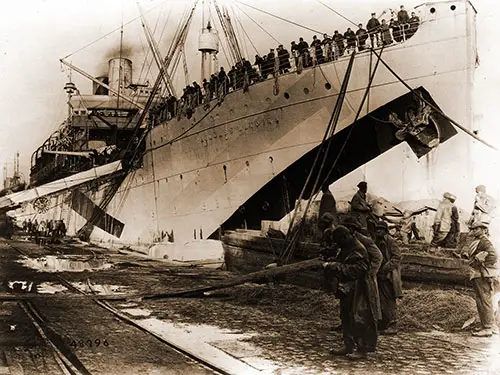
Men of the 43rd Railway Artillery Going Aboard the USS Princess Matoika, Bound for the United States at St. Nazaire, Loire Inferieure, France. Photograph Dated 20 December 1918. National Archives and Records Administration #2141-N9. GGA Image ID # 197944736e
Preparations for Sailing
The preparations for departure varied but little in the several units. The work of issuing final equipment to the troops went on feverishly day and night.
It was soon accomplished, however, and after a few days at the port the men found themselves aboard the transports ready to sail upon the Great Adventure.
The historian of Company K, of the 113th Infantry (Note 1 ), thus describes typical preparations for embarkation and some of the experiences of the voyage overseas:
“Here the final checking up of equipment and clothing was undertaken. It proved a very strenuous period for the Quartermaster; and with the issuance of clothing was connected many absurd and amusing procedures. For instance one morning at 2:30 the entire Company was routed out to receive an issue of shoelaces!
“The Company was here quartered in barracks, and, as Camp McClellan was a tent camp” was indeed a pleasing novelty to the men to be quartered in a real house and with spring cots to sleep upon. But owing to the confusion caused by the preparation for the great journey, little opportunity was allowed for enjoying the comforts thus afforded.
"Bed sacks were issued and ordered filled with straw. This was done and that night the men enjoyed the softest, most comfortable beds it had been their good fortune to sleep upon since leaving their homes, but, sad to relate, the bed sacks were ordered emptied the following day.
“On the 12th of June packs were ordered rolled and cots torn down. The cots were stacked in one corner of the barracks, while all squad rooms were thoroughly cleaned and policed.
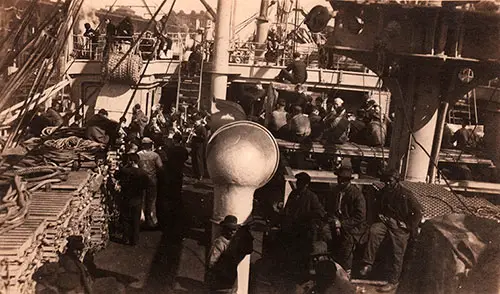
You can see the Band on the Lefthand Side of the Photograph. We have a Concert Every Noon at Sea. Some Stevedores are Visible in the Foreground. This Photograph of a Deck Scene on the USS Princess Matoika was Taken While Docked. nd. Circa 1918. Photographic Collection of the Gjenvick-Gjønvik Archives. GGA Image ID # 1979aeca69
“Great stress had been laid upon having every man’s hair closely cropped; thus it happened that each day and far into the night the barbers were kept constantly at work.
"On the night before the departure there was no sleep for anyone, and just as the first streaks of dawn began to appear, Thursday, June 18th, the company was lined up in the order that it would board the ship, and the final check before embarkation was taken.
"Many changes in the Company’s roster had been made since the date of its organization; some of the original members had been discharged from the service; others were transferred to different divisions, or other branches of the service, while many promotions and reductions had been made in the ranks.
“After a hasty breakfast of bread and jam and coffee, the company fell in with packs—and oh, such packs! They would have made a mule groan in dismay.
"Each and every pack contained, 1 O. D. blanket, 1 shelter half, with pole and pins, condiment can, bacon can, two suits of underwear, 1 pair of O. D. breeches, 1 O. D. shirt, four pairs of socks, 1 slicker, 1 overcoat, 1 mess kit, 1 entrenching tool, and toilet articles consisting of one razor, one comb, tooth brush, soap, talcum powder, and towels, besides personal effects, such as stationery, cigarettes, tobacco. Red Cross sweaters, etc.
"It was at least a three-mile hike to the dock and by the time the outfit reached there, the sun was high in the heavens and scorching hot. Every man was perspiring like a stoker on a battleship and panting like a lizard from the great exertion of the rapid march to the water.
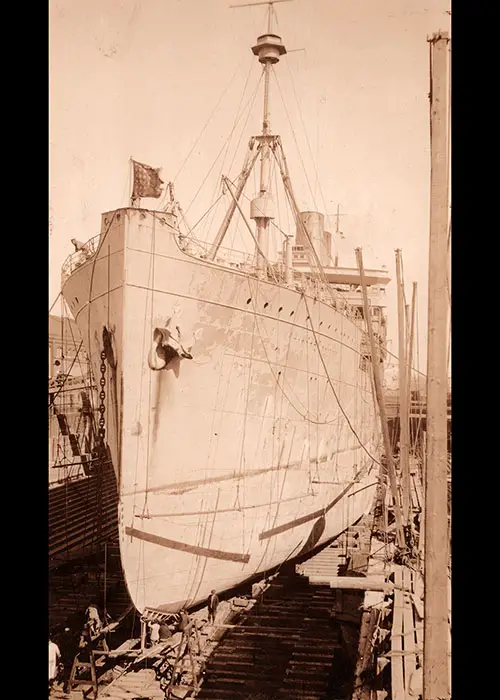
USS Princess Matoika in Dry Dock at Norfolk, Virginia during March 1919. Photographic Collection of the Gjenvick-Gjønvik Archives. GGA Image ID # 1979b2341a
On Shipboard with Company K, 113th Infantry
In a park near the dock, in the city of Newport News, they rested for a couple of hours. While here they were served with coffee and sandwiches by ladies of the Red Cross.
The outfit was hustled aboard the coast-wise steamer Norfolk which conveyed the troops out into the harbor where the transport Princess Matoika lay at anchor. This vessel by the way had quite an interesting history.
It was built by the German Government in 1910 and was christened the Princess Alice in honor of the Kaiser’s eldest daughter. Japan upon her entrance into the war seized the vessel, while she lay interned in one of her ports, renaming it the Princess Matoika.
The United States then purchased the boat from the Japanese or rather traded the vessel’s weight in steel for her.
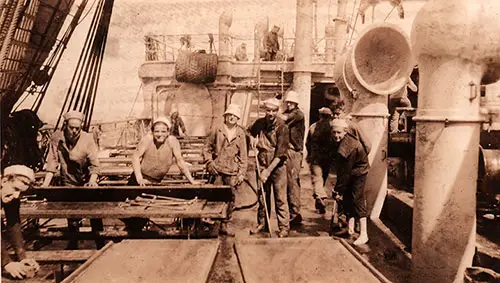
Sailors Attached to the Transport Ship “Princess Matoika” Holy Stoning Mess Tables on Deck in Advance of an Inspection. Ud, Circa 1919. Photographic Collection of the Gjenvick-Gjønvik Archives. GGA Image ID # 1979c31530
The Trip Over to England on the USS Princess Matoika
“Although the 4,500 officers and men of the 20th Division which the Princess Matoika was to convey to war-torn France were all aboard by the evening of the 13th of June, the vessel did not leave her moorings until the morning of the 14th. It was a great and novel experience for these “doughboys.”
They were unaccustomed to the cramped quarters they were forced to occupy, with the narrow canvas bunks swung deep down in the bowels of the ship. As a consequence there was much grumbling and, if the truth be known, not a little cursing.
“Great confusion and dissatisfaction also attended the first meal on board, owing to the lack of a specified system of procedure. More than 4,000 hungry men were crowding, jostling and shouting to lie served; and the afternoon of the first day aboard was well spent ere the last man had received his portion of rice, bread and coffee.
“The air below deck was suffocatingly warm, hence it was with scant good grace that the men received and obeyed the order to go below at sunset. They longed to remain on deck and enjoy the cool breezes that swept landward with the coming of evening.
"The following morning no one was allowed on deck as the presence of so many men would greatly impede the preparations for sailing. At eight A.M., the vessel got underway and two hours later when the men were allowed on deck the last blue line of the shores of dearly beloved old America was slowly fading from view.
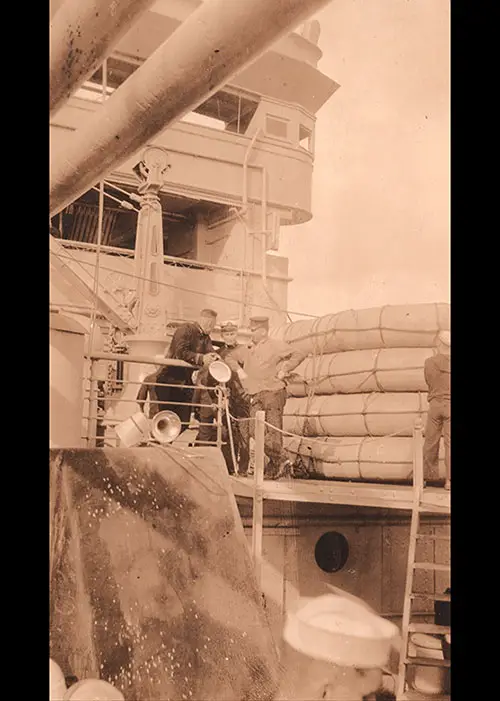
Conference Taking Place Between Lt. Gardner, Chief Engineer, Oliver, and Dr. Levy of the Transport Ship USS Princess Matoika. Ud, Circa 1919. Photographic Collection of the Gjenvick-Gjønvik Archives. GGA Image ID # 1979ed8be9
“Everyone crowded to the rail or clambered on the forecastle to get a last view of their native land. What the thoughts of each individual were as he stood gazing perhaps for the last time back upon the fast-fading outlines of his beloved land, would be hard to define.
"Perhaps he was thinking of home and loved ones; maybe his thoughts were of a sweetheart he was leaving behind, a sweet little woman with limpid eyes of blue, who had promised to await his return. Or maybe the vision of a dear old silver haired mother claimed his thoughts.
"Perhaps he remembered his childhood, and the happy days when he sat upon his grandfather’s knee and listened attentively to tales of the great Civil War.
"But be that as it may his new surroundings with their strange sights and sounds soon claimed his attention and he turned to gaze aloft as sailormen mechanically descended a swaying rope ladder from the dizzy heights of the crow’s nest, upon the mate’s sonorous command, shouted through a megaphone “relieve the man in the lookout”.
“Like the formation preserved by a flock of wild geese in flight, the fleet of transports hovered about the Princess Matoika as do those birds about their leader, for the Matoika was the flagship of the squadron.
"And on the left and right, as well as in advance and to the rear of the fleet, came the watch dogs of the sea that were acting as a convoy to the transports—handsome cruisers gliding majestically along, dashing torpedo boat destroyers, with their funnels set at a haughty angle, and tiny submarine destroyers darting hither and thither through the foaming spray like a school of flying fish at play; while overhead like keen eyed fish hawks circled huge hydroplanes, keeping a constant lookout for the Kaiser’s sharks of the sea.
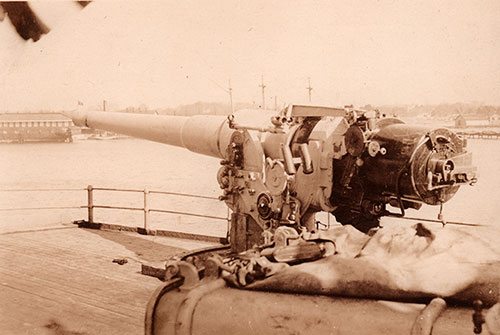
One of the Six-Inch Cannons Aboard the USS Princess Matoika During the War. nd. Circa 1919. Photographic Collection of the Gjenvick-Gjønvik Archives. GGA Image ID # 1979fc27e4
“After the first day on board a new plan was adopted for feeding the men that eliminated much of the confusion at first experienced. But two meals per day were served and each company had a separate specified time for eating.
The extensive Mess Hall was furnished with long tables at which the men stood while they ate, for there were no seats. In fact they ate on the run. Starting in on the head of one of the tables they were invariably at the foot, at the opposite end of the Mess Hall, by the time they had completed their meal.
“The sea was unusually calm, consequently there was little evidence of sea-sickness and the members of Company K came to the conclusion that they were immune to that dreaded malady.
"The first day out was an uneventful one— the weather was delightful and on the whole the men were in a very happy state of mind. They lounged about the decks smoking and chatting or spent the time in reading books procured from the ship’s library.
“The following morning, Sunday June 10th, was ideal. The sun rose above the liquid horizon like a great golden orange. Far away where the pule blue of the sky dipped to meet the deeper blue of the sea thin lines of smoke stretched like dull gray ribbons parallel with the horizon, to tell of the presence of Uncle Sam’s seadogs.
"So calm was the sea that it seemed utmost as if the ship was plowing through a sea of glass and its unruffled surface reflected the morning’s sunlight like a gigantic mirror.
"Such harmony of the elements seemed entirely foreign to so much as even a suggestion of war and strife. But suddenly and all unexpectedly, while K Company was at mess, like the sudden loosening of the winds from the Cave of Æolus, the boat’s siren began its unearthly shrieking.
"A submarine had been sighted. Almost immediately upon rising to the surface the underwater craft sent a torpedo, like a great winged monster of doom, toward the Princeps Matoika. Closer and closer came this engine of death leaving in its wake a silvery trail to tell from whence it came. But fortunately the torpedo fell short by but a few yards.
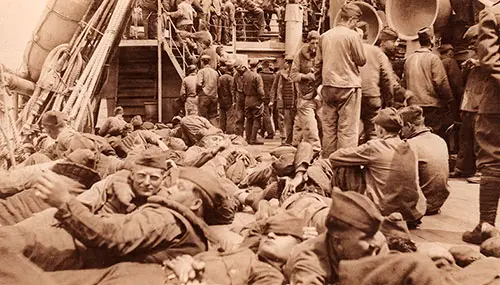
Homeward Bound Soldiers Taking a Sun Bath on the Deck of the USS Princess Matoika. nd. Circa 1918. Photographic Collection of the Gjenvick-Gjønvik Archives. GGA Image ID # 197a5bcfd9
Here the U-boat could fire another shot one of the two six-inch guns mounted on the Matoika’s forward deck, sent a shell after the submarine; and the second shot finished the career of the underwater raider. But there were other submarines and other shots were fired.
Submarine chasers and torpedo boat destroyers got on the job, with the result that two other U-boats met their Waterloo. When the alarm was given K Company was in line for mess.
Although every man realized full well the meaning of the sirens’ shrieking, many hesitated at leaving their place in the mess line. They apparently feared the loss of a meal more than the Kaiser’s “Hell Divers”, or as one patriot expressed it—“To hell with the submarine; let’s eat!”
With Headquarters' Company of the 115th.
“As soon as the three-mile limit was passed the war zone was entered, for German submarines had been doing their dastardly work along the coast. Life preserver jackets were issued to all the men and canteens had to be carried filled with water.
When darkness came on every port hole was covered and no lights were visible from without. No smoking could lie indulged in on deck, for even a glimmer might betray the ship’s location to the ever-vigilant enemy.
Different units were assigned to the different compartments. The Headquarters Company was bunked between two decks in the aft portion of the boat.
Officers went on guard in the holds and were on duty day and night to be prepared for any alarm to abandon ship and to aid the men in a quick and orderly clearing of the ship for the lifeboats.
The morning of the 16th saw five more transports added to the convoy, making thirteen in all, beside the battleship Texas and several torpedo boat destroyers accompanying as an escort.
The weather was beautiful, and the placid ocean mirrored the turquoise sky into a vast blue carpet. Those who had feared the ocean soon came to love it and would gaze for hours into its still depths.
“The convoy carrying its forty odd thousands of troops across to join their sorely pressed allies and brothers in France took up a formation resembling a column of squads with a distance varying some five hundred meters, while at night they would draw closer together as if for companionship.
"No lights could be seen and when darkness closed about only a dark outline of figures could be made out in the faint moonlight against the horizon. A straight course could not be followed, but a zig-zag path was taken across the waters. This was done to throw the submarines off the track if there should be any lurking about in stealthy waiting.
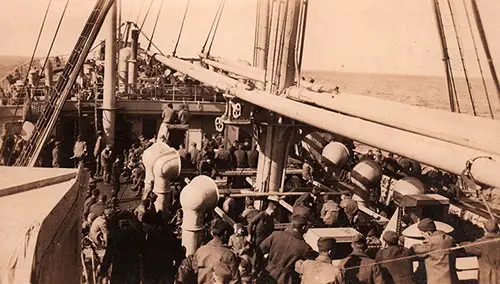
View of “B” Deck on the USS Princess Matoika, Filled with Soldiers, Men, and Equipment for the War. nd. Circa 1919. Photographic Collection of the Gjenvick-Gjønvik Archives. GGA Image ID # 197a6eced9
“In the fleet wore the S. S. George Washington, DeKalb, Ryndam, Dante Alighieri, Pastores, Finland, Wilhelmina, Lenope, Kroonland. Princess Matoika, Vanbon and Czar.
"On account of her speed the Leviathan soon disappeared from sight and raced to her port of destination, where she docked before her slower sisters were halfway across.
"The troops aboard were for the most part soldiers of the 29th Division, but on the Covington, occupying the entire forward part of her space, were colored draft men of the 366th Infantry.
"At first it was thought there might be some friction between them and the soldiers of the 115th Infantry. But these negroes were for the most part from the South, good humored and well behaved, and as there was no intermingling everything passed off happily. A tactful segregation was maintained between the white and colored officers.
“Life-boat and abandon ship drill were held each day until the ship if she were struck could be deserted in a very few minutes. At a certain hour all men would retire below and at a given bugle signal they would rush out of the hatches and crowd close to the rail; each deck was cleared in sequence until every man was up and ready to go over the sides. Life belts had to be worn at all times and canteens had to be kept filled.
“One quiet sunny day the siren whistle of the flagship, the George Washington, gave out three shrill screams which were answered by the others. Every man’s heart stood still, then all rushed below according to orders.
"Nothing happened and it was learned that the whistles were being tested. But the men said, might as well kill them as scare them to death.
"Once in a while one of the ships would drop back out of sight on the horizon and no one knew what had happened to her, but the next morning when the eager count was made, she had caught up again and was steaming along as if nothing has happened.
"Many guesses were made of what had happened, but none was ever the wiser. When mid-ocean was reached and the danger of submarines became less, the band would give concerts on the lower deck and the men would gather around and climb the riggings to listen.
"Boxing matches were held, and many games which did not require a lot of room for operation, —this included cards and dice. On Sunday, religious services were conducted, and the chorus of hymns floated out with the faint strains of sacred music and died in the distance.
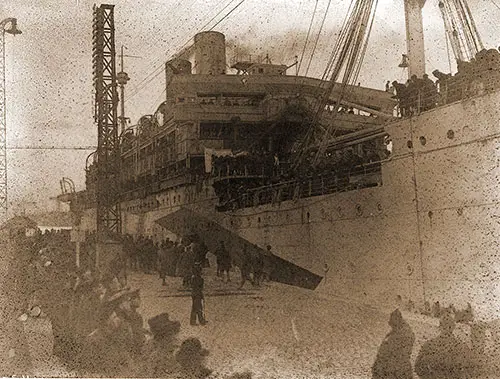
The USS Princess Matoika Entering the Locks at St. Nazaire, France, 20 December 1918. National Archives and Records Administration #2143N9. GGA Image ID # 197a88bf64
“The sea continued calm; every precaution for safety was maintained. The ghastly, blue lights below were all that illumined the passages as one groped around for his space, which might be at the distant end of a long line of canvas strung on iron rods, three high, and one above the other.
"All during the nights, when only the dull noises of the engines and the soothing swish of the water outside lulled the wakeful could be heard the pipe of the “bo’s’n’s” whistle and the call, “relieve the watch and the lookout”, —while the soldiers’ and sailors’ eyes were watching.
"Just at dusk one afternoon when everyone was on deck taking a last smoke before the lights were out, the siren on the George Washington pierced the air with six short shrill blasts like the cry of a wild, frightened animal and then her big stern guns opened up.
"Great fountains of white water shot up into the air between her and the Covington as the shells dug in for their prey. Each boat picked up the call and the sirens all about were screaming.
"Every gun that could be trained on the supposed enemy belched forth and depth bombs were dropped as the fleet scattered like a covey of flushed partridges.
"First the men rushed to the rail to see the long-looked- for submarine but prompt orders sent them below. In a few moments it was all over, and nothing was harmed, —not even the floating barrel which had resembled a concealed periscope and had brought the alarm which caused many hearts to stand still with the dread of a watery grave.
“The porpoises which so gracefully and swiftly played about the boat, the small flying fish that darted over the waves and the lazy whales that pushed their backs out of the sea, spouting a stream of water, giving a sight and disappearing, were a constant source of wonderment to the boys unfamiliar with the broad waters. Some even stayed up late at night to hear the bark of the hungry dog fish which the sailors told about.
"As the convoy neared land vigilance was renewed, watches were doubled and early one morning fourteen destroyers joined the fleet. It was a sign that the journey was nearing an end. These fleet little crafts ran in and out like so many fox terriers scenting rats and it would have been a bold submarine to show its nose above the water.
"On the morning of the 27th of June, in a wonderful azure sky several aeroplanes appeared like huge white gulls, and at ten o’clock the faint distant outlines of the coast could be seen.
"A grateful feeling of security and thankfulness crept into the hearts of all. At least they weren’t to be drowned like rats in a trap but would have a manly fighting chance for their lives.
"The Navy had out tricked the wily Hun. On this summer afternoon the convoy quietly filed into the harbor of Brest in a long column. Big lighters were brought alongside, and the troops debarked amid the strains of martial music.
"At last after weary months of training the company became a living part of the American Expeditionary Force and none knew how soon he would be called upon for the supreme test.”
Cutchins, John A., and George Scott Stewart, Jr. “Chapter XIII: Preparations for Sailing -- On Shipboard with Company K, 113th Infantry -- The Trip Over with Headquarters Company, 115th Infantry” in History of The Twenty-Ninth Division "Blue and Gray" 1917-1919 Prepared Pursuant to G.O. 2 Headquarters 29Th Division A.E.F., January 10Th, 1919, At the Request of The Division Historical Committee. 1st ed. Philadelphia: MacCalls & Co. Inc., 1921.
